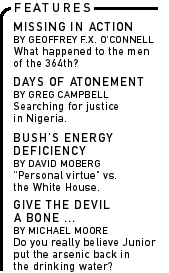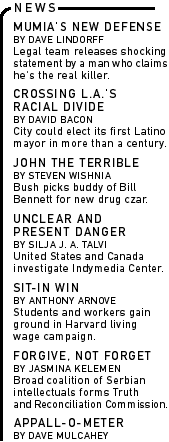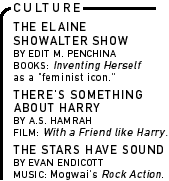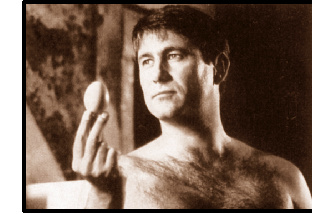

|

|

|

|
|
|
| |
|
|
|
With a Friend Like Harry By now you may have heard that the new French thriller With a Friend Like Harry is like Hitchcock or Chabrol; that's true. The name of its title character, Harry Balestero, evokes Hitchcock's The Trouble with Harry and The Wrong Man, where Henry Fonda played a character named Manny Balestrero; Dominik Moll, who directed, gives us a shot of Harry spying on the film's protagonist that more effortlessly recreates Hitchcock's shot of Anthony Perkins spying on Janet Leigh in Psycho than the one in the Psycho remake did. Harry is also free of the kind of editing gimmicks, pointless camera moves and head-smacking plot contrivances that work so hard to animate other contemporary thrillers like Memento, which was baked in the deepest dish its filmmakers could find. Moll saw no need to do that. The Hitchcock references are there just so you know he's not trying to hide anything. He realized it had to be that way, that his villain would demand comparison with Hitchcock's in Strangers on a Train; With a Friend Like Harry is also about two men who meet by chance while traveling. But who travels on trains anymore? This meeting takes place on the highway. And these guys aren't strangers. They went to high school together, only one doesn't remember the other, and the other remembers his classmate all too well. In Hollywood, it's the kind of plot that devolves into The Cable Guy. Like The Vanishing, another film it recalls, With a Friend Like Harry starts in a car.
The family pulls into a rest stop for a diaper change after a beautifully designed credits sequence--a restful break from the crying infants and a signal that Michel maybe needs a little distance from his family. While Michel washes up, he notices to his left a man with a weird smile staring at him and holding his hands out to dry. This is Harry (Sergi López), who after a protracted silence introduces (or reintroduces) himself to Michel. You don't remember me? One time you accidentally broke my teeth in gym class. Your father the dentist built me a new bridge. Later in the movie, after Michel's parents have both quite suddenly died, Michel will experience a toothache of his own. By then it should be clear to the viewers that the two former classmates share more than a history of mouth pain. It's not that Harry wants to extract revenge. On the contrary, Harry wants to help Michel. It's apparent from his new Mercedes, his curvy girlfriend named Plum (Sophie Guillemin) and his air of carefree, moneyed ease that Harry's the kind of guy who has solved all life's problems. The Michel he finds in the men's room isn't the one he remembers from high school. That Michel was sophisticated, full of potential, a writer. It's a version of himself that Michel has forgotten. He spends his time out in the country filling in a well; with every load of dirt he dumps in, he buries the adolescent Michel deeper. Harry advises him to rent a machine for his manual labor and get back to the real work of writing. When they last met, Michel was working on something called The Flying Monkeys. "It was more than just sci-fi," Harry explains to Claire at dinner. Later it asserts itself in a dream, complete with gibbon and propeller. Harry's reappearance in Michel's life drags a contradiction of bourgeois life out into the open: the desire to be an artist, living life on your own terms, vs. the desire to live a life of material ease. Michel wants to restore his farmhouse authentically, but he has to put up with the fuchsia bathroom his parents redid--after all, they helped him pay for the house. After letting Harry know the SUV he buys for them is "vulgar," both Michel and Claire start to like it and eventually come to depend on it. Harry's every action implies Michel can have it both ways, but this irreconcilable contradiction only leads to murder. The discomfort produced by this contradiction is what makes Moll's film work. Can anything good come of it? Even if the murders in With a Friend Like Harry are metaphors for the things Michel has to leave behind in order to write, they're still murders. If Harry and Michel can ultimately be seen as two aspects of the same personality, their individual guilt can never be assessed. After all, Harry Balestero's last name comes from the name of Hitchcock's quintessential innocent man, a man clearly blameless in the crime he's accused of, but around whose deteriorating marriage another kind of guilt lingers. Harry, as played by Sergi López, is such an excellent creation that the film glides very smoothly on his dissociated ingratiation. His menace is robust; his raw-egg-eating, for all its grossness, inspires Michel to start a new story. Once he's on the right track, Michel's like Shakespeare, he never blots a line. Harry has removed his block; can Michel dispatch Harry the same way once his usefulness goes too far? In Leos Carax's Pola X, a less subtle or examined film about an authenticity-seeking writer, Laurent Lucas played the villain, not the writer. Here, as Michel, he brings some of the self-satisfied pissiness from that movie to the hero's role. It's a tribute to Moll's intelligence that he created ideal roles for these actors, parts that uncomfortably combine niceness with vanity and ruthlessness with a desire to get along. The same thing is true of the other actors. Mathilde Seigner is changeable; annoyed and angular in one scene, peaceful and angelic in the next. (She's Emmanuelle Seigner's sister, and therefore Roman Polanski's sister-in-law; maybe that's good preparation for playing in films of unease.) Sophie Guillemin's Plum works subtly to keep Harry and everyone else happy; sensibly, all she wanted was to visit the Matterhorn. Moll doesn't insist they play types, and if it's obvious that by the film's end somebody has to go down in that well, you're never quite sure who it will be, or why. This makes Moll's view of his characters hard to untwine, but it
also makes for a thriller that's rich and complex. With a Friend
Like Harry aims for the clear-eyed indictment of bourgeois savagery
we've come to expect from a Chabrol, but it tempers it with metaphors
that make the characters enigmatic. When the film began, Michel
had forgotten his past. As it ends he carries a secret that will
be very hard to forget. But that he might is what disturbs you after
you've left the theater. Moll implies that violence was necessary
so Michel could become a person instead of a sap. The reason it
was necessary is rather chilling, and that's what separates Moll's
film so memorably from other thrillers. A.S. Hamrah writes for Hermenaut and Suck.com. He can be reached at hamrah@hermenaut.com. |


